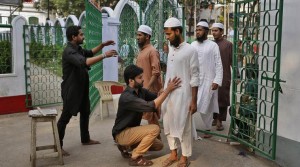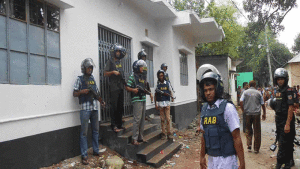MANTRAYA SPECIAL REPORT#09: 12 APRIL 2017
Bangladesh’s Unique War on the Islamic State
–
Bibhu Prasad Routray
–
Abstract
Bangladesh has launched a unique war on home grown militants with clear ideological linkages with the Islamic State, even while dismissing speculations regarding the IS presence in the country. Raids on militant dens, killings and arrests of militants have followed bigger and smaller terror attacks on Bangladeshi soil. Much of these terror neutralisation strategy, however, has remained mired in controversy and laced with allegations that the Awami League government could be attempting to protect its own interests while killing terrorists. This strategy of eliminating terrorism by eliminating terrorists may not be entirely effective, as Dhaka’spast endeavours demonstrate.
–
Overview
On 28 February 2017, 25-year old Amijul Islam was picked up by the Bangladesh police from Rajshahi district. A follow up official statement proclaimed Amijul to be the military chief (northern region) of the neo-Jama’atul Mujahideen Bangladesh (JMB), a militant group Dhaka describes as responsible for a number of terror attacks in the country in the past couple of years. Amijul’s family members, however, said that the young man was a petty electrician who struggled to make a living by doing odd jobs. In the wee hours of 1 March, Amijul was killed in Bogra district. Police explained that Amijul who had been taken to the district to recover weapons and arrest his accomplices was shot by extremists who attacked the police van.
Similarly, 30-year old Khaled Hasan alias Badar Mama, the previous chief of neo-JMB’s north Bengal division too was killed in a mysterious pre-dawn shootout in Sherpur district on 29 August 2016.Badar Mama was allegedly involved in an attack on a temple and a bid to kill an Italian priest in 2015. In another incident, Hanif Mridha, arrested after the 17 March 2017 suicide attack on the barracks of the Rapid Action Battalion (RAB),the country’s elite anti-crime and counter-terrorism force, died in custody the next day. While RAB claimed that Hanif, a neo-JMB cadre, was picked up while hiding in a bush, Mridha’s family members, however, claimed that he had been picked up by the police personnel on 27 February, three weeks before his death along with another friend Md Sohel Hossain Mantu. They also claimed that RAB personnel forced them to pay Tk 670,000 (US$ 8300) promising Hanif’s release. Hanif had a thriving transport business before his arrest. Sohel Hossain Mantu remains untraceable.
Kinetic operations plus
(The aftermath of the 1 July 2016 attack on the Holey Artisan Restaurant, Dhaka, Photo: BD News)
As Dhaka continues its counter-terrorism efforts against Islamist radicalism, especially after the 1 July 2016 terror attack on the popular Holey Artisan restaurant in Dhaka’ upmarket Gulshan area that killed 22 people, stories of such raids, encounters, and arrests appear on the front pages of newspapers, narrating the country’s progress in dealing with terror with an iron fist. Successive kinetic counter-terror operations- ‘Hit back’, ‘Maximus’, ‘Twilight’, ‘Storm 26’-have all been declared successes and have apparently ended up diminishing the strength of the Islamists. According to the South Asia Terrorism Portal, since the Holey Artisan restaurant attack, 78 Islamist terrorists have been killed and another 907 arrested across Bangladesh.
Arrested militants dying during incidents of crossfire or failed escape attempts, an euphemism for staged encounters, has at least a decade-long history in Bangladesh. The country broke the back of the ragtag left-wing extremism by relying on a similar tactic killing hundreds of so called extremists. Since 2005, the same tactic has been employed to subdue a new crop of militants. And Bangladesh earnestly believes that it can eliminate terrorism by eliminating terrorists. On September 3, 2016, Home Minister Asaduzzaman Khan had said: “If you do not give yourself up to the law enforcement agencies, you will face what your accomplices have experienced in the immediate past operations.”
Killings of Amijul, Badar Mama, Hanif Mridha and others, thus, need to be seen in the wider context of the impunity that anti-terror forces such as the RAB, the police and the Counter Terrorism and Transnational Crime (CTTC) may have been provided with, to clean up Bangladesh. It is possible that majority of those eliminated were indeed terrorists. Even then, were they neutralised under a regime that promotes excesses and extra judicial killings and what would be the long and medium-term impact of such a strategy remain moot questions. That the ‘national’ desire to have a stable and trouble free Bangladesh may have eclipsed the principles of law was brought out by the United Nations Office of the High Commissioner for Human Rights in its 28 March 2017 report which criticised the country for high rates of extrajudicial killings, enforced disappearances, muzzling of dissent and free speech. In addition, Bangladesh based human rights organisations like Ain O Salish Kendra (ASK) and Odhikar have documented the unceasing extrajudicial killings despite a 2008 promise by the Awami League in its election manifesto. According to the ASK, between 2010 and 14 March 2017, 793 such killings have taken place. The ASK says that killings have particularly increased since the formation of the RAB in 2004. “The incidence of ‘crossfires’ and ‘gunfights’ has increased in the name of ‘anti-militant drives’, it notes in a number of its documents. In 2017 (between 1 January and 14 March), at least 51 people were killed in gunfights or crossfires. Of them, 38 people were killed by police, six by RAB, five by Detective Branch (DB) police, one by joint forces and one by the army, according to an ASK report.
On 4 April 2017, Sveriges Radio, Sweden’s national publicly-funded broadcaster, aired parts of a conversation with a high-ranking RAB official. The official, who himself has been involved in a number of extra judicial killings, confirmed that not all killing of militants are clean. “If you find him – shoot and kill him, wherever he is. And then plant a weapon beside him. This is often the order.” The official also said that such weapons are bought out of the money RAB collects from the criminals as bribes. He went on to explain the raison de etre: victims of extrajudicial killings are usually “people who they suspect of serious crimes, but who they consider too difficult to convict in a trial, or impossible to rehabilitate”. The RAB dismissed the report as “vague” and “unclear” and affirmed that it operates “in line with law”.
A Unique Effort
(Visitors being frisked at the entrance of a Shia shrine in Dhaka where unidentified attackers hurled home-made bombs on 24 October 2015, Photo: Indian Express)
Notwithstanding the contradictory claims of the human rights groups and the security force establishment, massive operations against the Islamists in Bangladesh remains part of its unique counter terrorism policy. Firstly, as it continues to witness large as well as small terror attacks since past few years, the Awami League government continues to reject the claims and assumptions that the Islamic State could have been responsible for a majority of these attacks. Rejecting the claims made by the IS and evidences of inspirational linkages between the IS and the home grown radicals, Dhaka insists that the home grown neo-JMB is responsible for these terror attacks. Peculiarly, however, official estimates concede that the neo-JMB which surfaced in 2014, “is far more radicalized and fearsome” and is “influenced by the IS ideology”. Secondly, the country’s leadership genuinely believes that reliance on a kinetic approach alone is sufficient to deal with such brand of terrorism. The official approach is best summed up in the 8 October 2016 statement of Prime Minister Sheikh Hasina who said, “Our government has always taken stern action against terrorism and militancy and would continue to curb the twin demons with an iron hand”.
IS and Home-grown terror: Evidence of Linkages
(Screenshot of an Islamic State propaganda video in which the outfit published photographs of the terrorists involved in the attack on the Holey Artisan Restaurant )
Notwithstanding its denial, several pointers prove the ideological, logistical as well as inspirational linkages between the IS and the Islamist radicals within Bangladesh.
Firstly, with regard to an end state, there is little that separates the JMB and the IS-inspired terrorists. Through the pamphlets left at the sites of the explosions in 2005, the JMB proclaimed itself to be the “soldiers of Allah” who have “taken up arms for the implementation of Allah’s law the way Prophet, Sahabis and heroic Mujahideen have done for centuries”. The Islamic State’s proposed caliphate works towards a similar objective, rejecting modernism and embracing anti-secular jihad against the apostates.
Secondly, Bangladeshi nationals have periodically featured in IS-sponsored videos calling for taking forward the group’s agenda of making Bangladesh a part of the proposed Islamic caliphate. Attacks have typically followed major IS announcements. The 17 March 2017 attack on the RAB barracks in Dhaka took place two days after the IS’ call for suicide attacks within Bangladesh.
Thirdly, amid IS claims owning responsibilities for a bulk of the attacks, investigations have established that funds, at least on one occasion, was donated to the neo-JMB terrorists by a doctor who fled to Syria. Rokonuddin Khondoker, a paediatrician of Dhaka Shishu Hospital who fled to Syria with his family in 2016 had asked several of his relatives and others who owed him around Taka 8 million (US$ 100,000) to give the money to the radical group instead of paying him back.Only a part of this money, however, reached the outfit. In addition, there have been instances when funds were moved from middle eastern countries into Bangladesh for carrying out terror attacks.
Fourthly, the pattern of attacks, since the attack on the Holey Artisan Cafe, too point at the consolidation of the IS in Bangladesh. Most recent attacks by the neo-JMB have targeted the security forces. This is a common occurring in countries where local outfits have graduated to become IS sympathisers. In Indonesia and Philippines, for instance,the recent IS-inspired attacks have mostly targeted the state structure.
Fifthly, the fact that suicide terrorism, arguably representing the highest state of radicalisation among the recruited, has been regularly employed in Bangladesh further point at a stark likelihood of IS influence over the trend of Islamist radicalism. In a country of moderate Islam, where culture is assigned prominence over religion, the terror formations have been able to recruit a sizeable number of people who are prepared to kill themselves in the name of religion. The neo-JMB carried out its first ever suicide attack on 26 December 2015 on an Ahmadiyya mosque in Rajshahi’s Baghmara. Since then a number of such attacks using suicide bombers have been carried out.
Contestations over Name
(RAB operation in Tangail where 11 neo-JMB cadres were killed in October 2016)
Even though similar attempts in the past to kill terrorists have not entirely succeeded in eliminating terrorism (the neo-JMB bounced back within few years of the marginalisation of its predecessor), Dhaka’s action reflects its concern regarding the rise of radicalism in the country. In this regard, the denial appears strange, although not completely out of place.
Firstly, Dhaka’s posture is a legacy of the past. There is an official history to this tactic of denying what is obvious. Even while the JMB carried out over 450 serial explosions in 63 of Bangladesh’s 64 districts in August 2005, then Home Minister of the Bangladesh Nationalist Party (BNP) flatly refused to acknowledge the existence of the outfit. BNP’s senior policy makers described the bombings as the result of a “conspiracy”. Then Industries minister Maulana Matiur Rahman Nizami of the Jamaat-e-Islami (JeI), BNP’s coalition partner, blamed India’s Research and Analysis Wing (RAW) and the Israeli Mossad for playing “an important role” in the attacks. It took eight days for the BNP government to admit that the JMB was behind the attack.
Secondly, Dhaka fears that admitting the intrusion of the IS into may affect the investment environment, especially in the country’s thriving garment industry, whichhas withstood world economic meltdowns and competitions from rival countries. Garment industry in Bangladesh is worth US$26 billion, represents 80 percent of Bangladesh’s exports, and employs four million people.Demonstrating that the terror is perpetrated by local actors who can be curbed effectively by state, the government hopes to prevent steps of the foreign brands who pulled out their staff following the 1 July Holey Artisan restaurant attack.
And thirdly, Dhaka also feels that admitting the IS presence may weaken its ongoing action against the Pakistan collaborators in the 1971 war of liberation. For a good measure the neo-JMB is linked to outfits like the Jamaat-e-Islami and Islami Chattra Shibir many of whose leaders have either already been hanged or are currently facing judicial action. There is some level of pressure from the Americans and the British on Dhaka to go slow on this processes which have been described as hasty and not entirely legal.
Conclusion
There is no denying that Islamist militancy poses a grave danger to Bangladesh’s security antid stability. However, the ability of kinetic operations alone to deal with the threat which has deep roots in the country’s polarised politics and unhindered mobilisation of radical Islam is limited. Since such efforts in the past against the JMB have only been temporarily successful, there are ample reasons to believe that present efforts, no more than replicas of the past, will only produce limited results. Moreover, with a licence to kill and arrest people, many of whom would probably be innocents, without legal oversight, such operations may actually contribute to the recruitment and mobilisation capacities of the Islamists.
References
Ahmed Zayeef, “Died in RAB custody, Hanif picked up 20 days ago: Family”, Prothom Alo, 20March 2017, http://en.prothom-alo.com/bangladesh/news/142775/Died-in-RAB-custody-Hanif-picked-up-20-days-ago
“Bangladesh police kills JMB commander behind temple attack”, The Hindu, 29 August 2016, http://www.thehindu.com/news/international/Bangladesh-police-kills-JMB-commander-behind-temple-attack/article14596390.ece
Ben Chapman, “Bangladesh clothing industry hit by terror attack fears as fashion brands pull staff out”, Independent, 5 July 2016, http://www.independent.co.uk/news/business/news/bangladesh-terror-attack-travel-warning-fashion-clothing-companies-marks-and-spencer-uniqlo-h-and-m-a7121066.html
Bibhu Prasad Routray, “The JMB survives”, Outlook, 8 February 2007, http://www.outlookindia.com/website/story/the-jmb-survives/233825
Haroon Habib, “Warning blasts”, Frontline, vol. 22, no. 19, 10-23 September 2005, http://www.frontline.in/static/html/fl2219/stories/20050923001106200.htm
Kamrul Hasan and Tarek Mahmud, “Suicide bomber attacks RAB barracks”, Dhaka Tribune, 17 March 2017, http://www.dhakatribune.com/bangladesh/2017/03/17/one-killed-blast-near-rab-camp-ashkona/
Mahadi al Hasnat, “Extrajudicial killings: 51 die in three months”, Dhaka Tribune, 19 March 2017, http://www.dhakatribune.com/bangladesh/2017/03/19/extrajudicial-killings-51-die-three-months/
“Terror Financing: Rokon gave Neo JMB Tk 80 lakh”, Daily Star, 19 October 2016, http://www.thedailystar.net/backpage/terror-financing-rokon-gave-neo-jmb-tk-80-lakh-1300675
“Swedish radio report on extrajudicial killings vague: RAB”, BD News, 5 April 2017, http://bdnews24.com/bangladesh/2017/04/05/swedish-radio-report-on-extrajudicial-killings-vague-rab
“Terror financing in Bangladesh: Dhaka doctor gave Neo JMB $100,000”, Asia News network, 19 October 2016, http://asianews.network/content/terror-financing-bangladesh-dhaka-doctor-gave-neo-jmb-100000-30783
“UN criticizes Bangladesh over dismal human rights record”, UCA News, 4 April 2017, http://www.ucanews.com/news/un-criticizes-bangladesh-over-dismal-human-rights-record/78845
(Bibhu Prasad Routray is Director, Mantraya. This Special Report is published as part of Mantraya.org’s ongoing “Islamic State in Asia” and “Mapping Terror and Insurgent Network” projects.)
To download a PDF version of this special report click here: “Special Report: Bangladesh’s Unique War on the Islamic State“
To Read previous Special Reports, CLICK HERE






